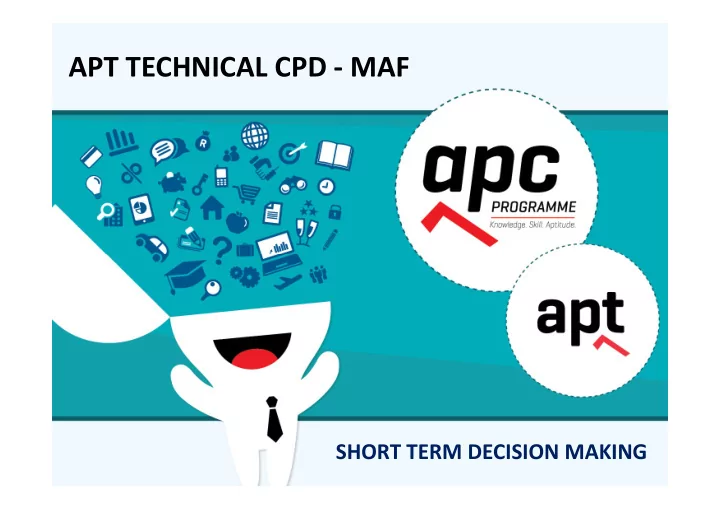

APT TECHNICAL CPD - MAF SHORT TERM DECISION MAKING
Short term decision making and pricing strategy Nicholas Riemer Nicholas.Riemer@firstrand.co.za
Agenda • Workflow to understanding short term decision making and pricing strategy • What is short term decision making and pricing strategy? Generic Problem (theory) • How to address short term decision making in industries and APT context? • How to address short term decision making in industries and APT context? • How to incorporate into your file
Workflow Approach
STDM Generic problem • Objective of FM is maximisation of shareholders wealth! • Therefore the objective of all decision making is to ensure maximisation of shareholders wealth. • Short term – “non-routine”, “once-off” – so maximise net cash inflows over short-term! • Maximise contribution – remember relevant fixed costs!
Theory of Relevance • “Cash flow as a result of decision” • “Difference between status quo and what I am considering” • Difference between Qualitative vs. Quantitative (industry research comes in) • Relevance and the following concepts: – Avoidable cost / sunk cost / opportunity cost
Decision making considerations In industries • Difference between Short-term and long-term decision making – LT • Cash flows (or profit!?) (including all fixed and variable costs as well as capital expenses) • The time value of money • Take risk into account through discount rate – ST • Cash flows? All costs? Capital expenses? – Only costs relevant to the decision – mostly variable (in other words contribution) but could include relevant fixed cost as well as relevant capital expenditure (examples) (Only relevant info) • Time value of money? – No! • Don’t take risk into account – assume certain!
Short Term Decision making • What is contribution? – Income from sales minus all variable costs (manufacturing or non-manufacturing) – Recap “Costing” (Decision making vs. inventory valuation) • Why is contribution so important? – It indicates the change in “profit” assuming fixed cost does not change – Or it indicates the amount available to cover all fixed costs – If a division doesn’t make profit – should we close down? These are the types of practical applications of the theory.
Short Term Decision making • Constraints – What must we do? CULF – Basic principle! Maximisation of shareholders wealth – Qualitative vs. Quantitative.
Short Term Decision making from a practical view • Types of ST decisions (Amongst others in industries!): – Special order / short term pricing • Approach: – Identify all variable cost (relevant) plus any relevant fixed cost plus relevant capital expenditure plus any opportunity cost. All these added together will be the minimum price achieving a contribution of zero. Any required contribution will be added to minimum price to determine the short term price – Therefor practically you would research short term contributions being made in that specific industry. – And then try and identify relevant costs in the pre release should this be triggered.
Types of decisions (continued) – Make or buy decision (outsourcing) • Approach: – Determine what the product or service will cost if made by company: » Identify all variable cost plus relevant fixed cost plus relevant capital expenditure plus any opportunity cost and compare to » The cost of buying the product in or outsourcing the service » Should price for outsourcing be required then the cost to manufacture self will be the maximum outsourcing price » Again practical/industry research would be to get an idea of what competitors in the market are currently doing? » Examine the balance sheet to see if assets are on balance sheet to manufacture or if outsourcing fee included in COS
Types of decisions (continued) – Closing of a business unit or product range • Approach: – Which cost will be saved (avoided) over the short term should the unit / product be closed? – What income will be lost over the short term should the unit / product be closed? – The net between above two will indicate the financial implications of the closure (obviously non-financial consideration will have to be considered as well) – Practically, what real life qualitative aspects to be researched? – Labour law issues? – Tax issues ? – Possible accounting issues in segment reporting?
Other important aspects • Qualitative factors – EXTREMELY NB!! – Most of these points will come from industry research. – Think all disciplines when examining qualitative aspects – Always qualitative aspects to a decision, never the quantitative answer in isolation.
Pricing decision Generic problem • Price taker vs. Price setter • Cost plus vs. target • Short vs. long-term pricing • Strategy – Product differentiation. • Pricing strategies – Price skimming – Premium pricing – Penetration pricing – Loss leader – Product bundling/optional extras
Pricing decision • Approaches to pricing: – Cost (standard or actual?) • Variable cost • Absorption cost • ABC-cost • Mark up% (ignore demand) – Target costing • Selling price (as determined by marketers after market research) • Required return (what return is required to earn fair rate of return on capital) • Target cost
Building a file for coverage • My File. • Theory in terms of the short term decisions needed summarized on a 1 pager. NB • Coverage, all questions asked of you labelled for the trigger in the pre release • A summarized sheet with the different short term and pricing decisions available with adv and disadvantages for each. • The practical/industry information summarized relating to the above topic • All the information used for the above attached behind the summaries for more detailed use when needed. • All the best!
Recommend
More recommend